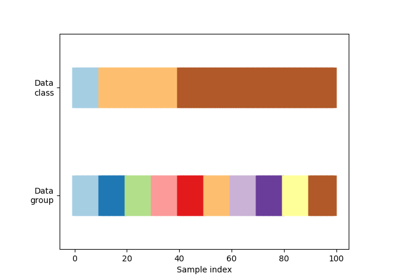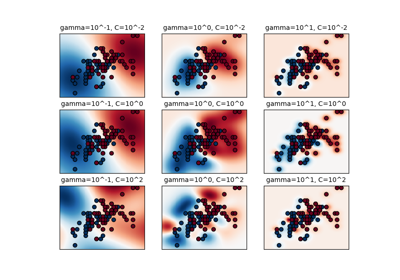sklearn.model_selection.StratifiedShuffleSplit¶
-
class
sklearn.model_selection.StratifiedShuffleSplit(n_splits=10, test_size=’default’, train_size=None, random_state=None)[source]¶ Stratified ShuffleSplit cross-validator
Provides train/test indices to split data in train/test sets.
This cross-validation object is a merge of StratifiedKFold and ShuffleSplit, which returns stratified randomized folds. The folds are made by preserving the percentage of samples for each class.
Note: like the ShuffleSplit strategy, stratified random splits do not guarantee that all folds will be different, although this is still very likely for sizeable datasets.
Read more in the User Guide.
Parameters: - n_splits : int, default 10
Number of re-shuffling & splitting iterations.
- test_size : float, int, None, optional
If float, should be between 0.0 and 1.0 and represent the proportion of the dataset to include in the test split. If int, represents the absolute number of test samples. If None, the value is set to the complement of the train size. By default, the value is set to 0.1. The default will change in version 0.21. It will remain 0.1 only if
train_sizeis unspecified, otherwise it will complement the specifiedtrain_size.- train_size : float, int, or None, default is None
If float, should be between 0.0 and 1.0 and represent the proportion of the dataset to include in the train split. If int, represents the absolute number of train samples. If None, the value is automatically set to the complement of the test size.
- random_state : int, RandomState instance or None, optional (default=None)
If int, random_state is the seed used by the random number generator; If RandomState instance, random_state is the random number generator; If None, the random number generator is the RandomState instance used by np.random.
Examples
>>> from sklearn.model_selection import StratifiedShuffleSplit >>> X = np.array([[1, 2], [3, 4], [1, 2], [3, 4], [1, 2], [3, 4]]) >>> y = np.array([0, 0, 0, 1, 1, 1]) >>> sss = StratifiedShuffleSplit(n_splits=5, test_size=0.5, random_state=0) >>> sss.get_n_splits(X, y) 5 >>> print(sss) StratifiedShuffleSplit(n_splits=5, random_state=0, ...) >>> for train_index, test_index in sss.split(X, y): ... print("TRAIN:", train_index, "TEST:", test_index) ... X_train, X_test = X[train_index], X[test_index] ... y_train, y_test = y[train_index], y[test_index] TRAIN: [5 2 3] TEST: [4 1 0] TRAIN: [5 1 4] TEST: [0 2 3] TRAIN: [5 0 2] TEST: [4 3 1] TRAIN: [4 1 0] TEST: [2 3 5] TRAIN: [0 5 1] TEST: [3 4 2]
Methods
get_n_splits([X, y, groups])Returns the number of splitting iterations in the cross-validator split(X, y[, groups])Generate indices to split data into training and test set. -
get_n_splits(X=None, y=None, groups=None)[source]¶ Returns the number of splitting iterations in the cross-validator
Parameters: - X : object
Always ignored, exists for compatibility.
- y : object
Always ignored, exists for compatibility.
- groups : object
Always ignored, exists for compatibility.
Returns: - n_splits : int
Returns the number of splitting iterations in the cross-validator.
-
split(X, y, groups=None)[source]¶ Generate indices to split data into training and test set.
Parameters: - X : array-like, shape (n_samples, n_features)
Training data, where n_samples is the number of samples and n_features is the number of features.
Note that providing
yis sufficient to generate the splits and hencenp.zeros(n_samples)may be used as a placeholder forXinstead of actual training data.- y : array-like, shape (n_samples,)
The target variable for supervised learning problems. Stratification is done based on the y labels.
- groups : object
Always ignored, exists for compatibility.
Yields: - train : ndarray
The training set indices for that split.
- test : ndarray
The testing set indices for that split.
Notes
Randomized CV splitters may return different results for each call of split. You can make the results identical by setting
random_stateto an integer.



